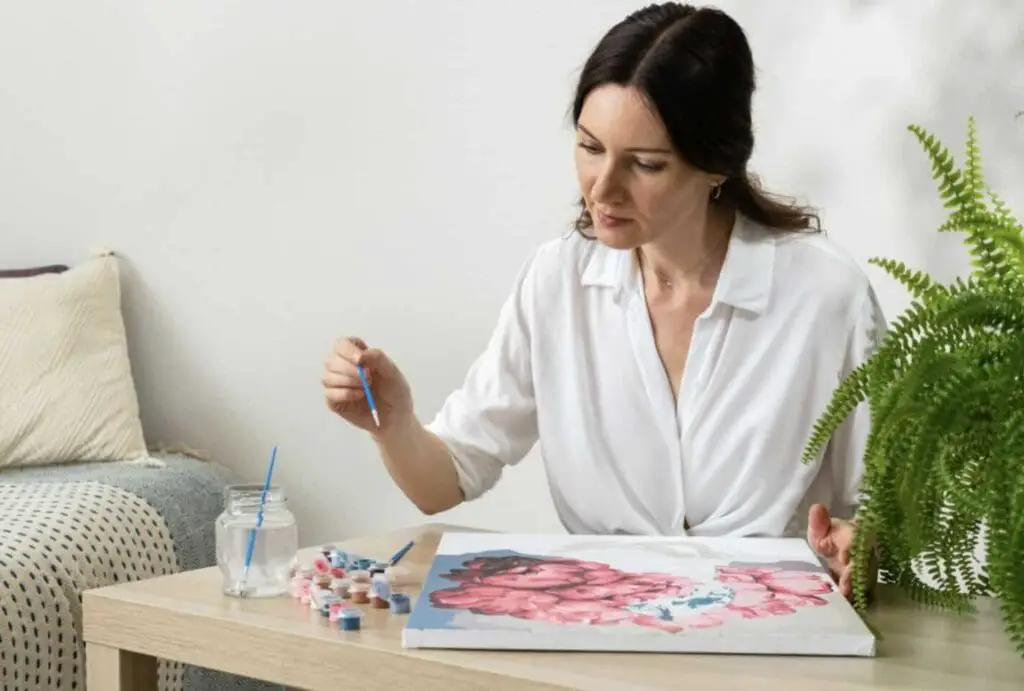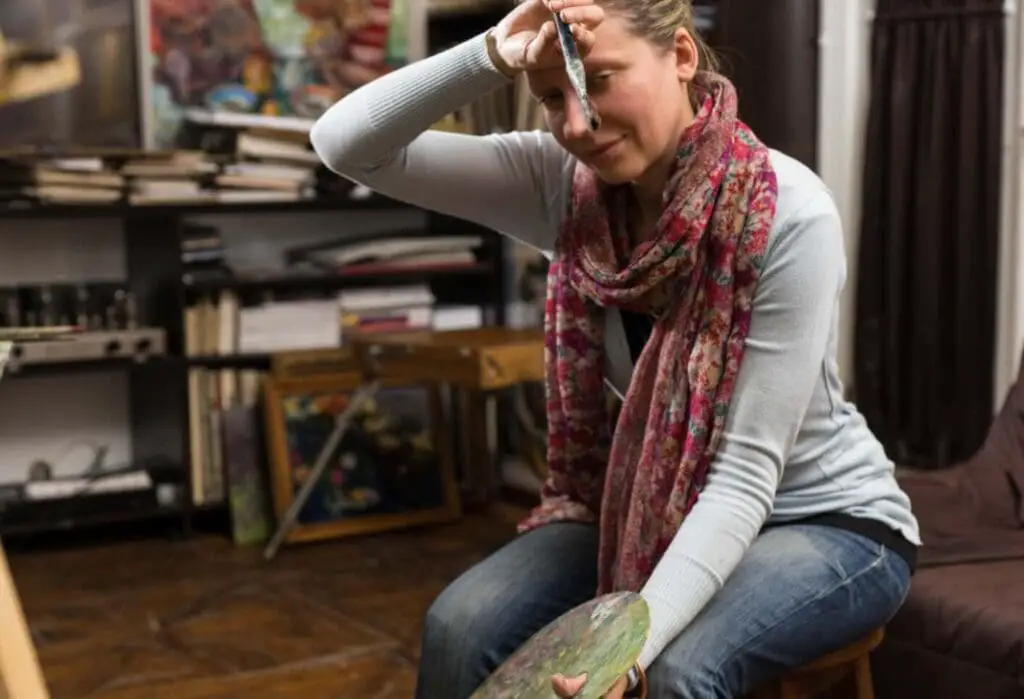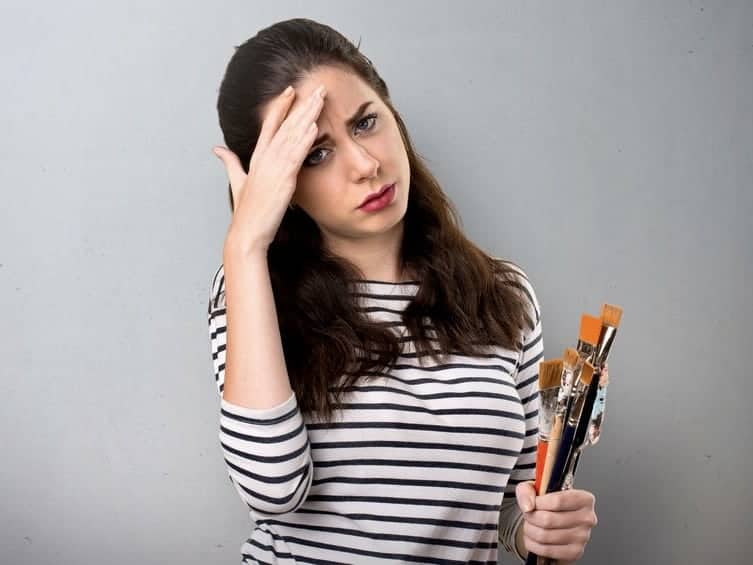Sometimes, when people start painting, they may find that they keep having an artist block. It can sometimes be hard to decide what to paint or start with the painting.
There are several reasons for an artist’s block, including timing, fear, perfectionism, or a lack of motivation. Fortunately, there are some simple steps you can take to try to overcome an artist’s block and get back to doing the art that you love.
Table of Contents
- Common Causes of Artist Block
- Here Are 10 Tips To Overcoming Artist Block
- Have A Plan In Place
- Don’t Worry About Perfection, Just Get Started.
- Go for a walk and change your scenery
- Find A Way To Get into a Creative Zone
- Eliminate Distractions
- Change your environment
- Scan the internet for inspiration
- Make it a habit to create artwork.
- Remember why you started to paint in the first place.
- Do creative exercises to get the creative juices going.
- Frequently Asked Questions
- Related Content
Common Causes of Artist Block
it helps if we can first define what causes an artistic block. If we know what causes the artist block then we can find ways to adjust things in our life to overcome these obstacles.
Timing
It is simply not the right time to be creative, or your life may be so busy with other responsibilities that you have no time to start a new project or new artistic pursuit.
I do believe everyone should find some time in their lives to have some art or a creative pursuit as part of their lives. I think that art and artistic pursuits can help with many other areas of our lives. Having creativity in your life can help with things like being able to solve problems in other aspects of your life. The reason is that being creative allows you to look at things from different angles, so it means you can also see problems from another angle.
Fear
Afraid to put something down on the canvas as you are afraid you will mess it up. Once you put just one brush stroke down on a canvas, it is no longer blank. Your painting has now been started.
To find more about how to overcome the fear of a blank canvas, you can read more by our blog 11 Tips to Overcoming the Fear of a Blank Canvas by clicking here.
Perfectionism
Want it all to be perfect?. Learning to paint and doing it well takes a lot of time. The first picture you paint will not be ideal. In fact, the truth is that many of the first paintings you paint you may not be happy with. It will take time, and it will be a process for you to find your artistic voice.
And like most artists, your artistic voice may change many times during your lifetime. Your style will evolve and change, but this is a good thing.
You should see your art and artwork as a process. Meaning it will be a process that will constantly change and evolve.
Simple Lack of Motivation
Sometimes, we mean to start painting but somehow never quite get started despite our best efforts. We may have good intentions but lack motivation.
If you find yourself not being motivated to start painting, try to make the painting process as easy as possible. Have a place set up to paint, and make sure it is easy for you to get to the canvas and start painting.
The more complicated you make the process of painting, the more difficult it will be to paint. Sometimes, people try to make it very complicated to paint, but if you can make it easy for you to start painting, you have a much better chance that you will actually start painting.
Michelangelo reminds us that we must work hard in our artistic pursuits. He said:
“If people knew how hard I worked to get my mastery, it wouldn’t seem so wonderful at all.“
Michelangelo

Here Are 10 Tips To Overcoming Artist Block
If you have an artist block, there are several things that you can do to overcome your artist block. Here are some tips to help you overcome the artist-creating block.
Have A Plan In Place
If you have a plan in place, this will help you ensure you get in some painting time. You do not want this to feel like an endurance workout or work as painting, and your artistic endeavors should be enjoyable and, if possible, relaxing.
But studies have shown that if people have a plan or a schedule, they are more likely to do what is planned or scheduled. Just like I know when I go swimming with a plan written up, I am more likely to get in more laps in the pool than without a plan.
So, painting and artistic pursuits are the same. If you have some kind of plan, you will more than likely get in more hours improving your painting or artistic skill than without a plan or routine.
Don’t Worry About Perfection, Just Get Started.
Don’t worry about trying to paint that perfect picture. Instead, look at your painting as a process and not a destination.
Here are some ways you can look at the painting as a skill that you will be constantly improving:
- Start painting – Start painting your first painting and then look at it and decide what you need to improve. My first painting was a woman, and I struggled a lot with the nose. So, I spent a lot of time learning how to paint a nose.
- Take a class – if you are able, take an art class. This will not only help you with instruction, but also you will be able to meet other like-minded artists.
- Learn online- If you are not able to take a class, then you can continue your art learning through many online platforms. The Virtual Instructor specializes in online art instruction and has a wide range of live and recorded art classes at a reasonable price. Also, there is a lot of art instruction on YouTube.
Edgar Degas reminds us that he was never quite satisfied with his art. He teaches us that being an artist means it is a constant process of learning and looking for the next great painting we will paint. He said:
“One must have a high opinion of a work of art – not the work one is creating at the moment, but of that which one desires to achieve one day. Without this it is not worthwhile working.”
Edgar degas
Go for a walk and change your scenery
If you are stuck for inspiration, go out and take a walk with your sketchbook or camera. Take photos and sketch out ideas of things you want to paint.
Nature offers us a lot of great inspiration. Even for things like abstract art, you can look at the natural light in nature with ideas of ways to paint. If you know how to look at nature, you can find a lot of great inspiration in nature.
Edgar Degas reminds us that
“Even in front of nature one must compose.”
Edgar Degas
Find A Way To Get into a Creative Zone
Different things affect different people in different ways. For some people, they may see a beautiful sunset, and this inspires them to want to paint it. For others, it may be travel or the lights of a major city.
Find out what inspires you for your own creative zone. So if you are stuck, then try to go to that creative zone to get inspired and get out of your artistic block.
If you cannot travel or get inspired, try to go online and get some inspiration online. In today’s world, you can get online and find much inspiration. Sites like Pinterest are great as you can go on Pinterest and, with some quick searches, see what other people are looking at or what inspires them.
Eliminate Distractions
If your problem is that you have too many distractions in your life, then you can also look at ways to eliminate or control your distractions so that you can have the time to paint.
Here are some ways to help eliminate distractions
- Turn off smartphone notifications – It can be a huge distraction when every 5 or 10 minutes, your phone is dinging as someone posted on Facebook or there was some new news. These kinds of distractions can take you away from your creative zone.
- Find a quiet place to work – Find a quiet to work so that you can concentrate on your painting,
- Listen to some nice music – Sometimes music can inspire you and lift up your spirits, so put on some nice music while you are painting.
Change your environment
You may need to change your environment to find inspiration for your artwork.
Here are some ways you can look to change your environment:
- Change where you paint – It could be as simple as moving where you are painting. Sometimes, we can see things from a new angle just by moving things around a bit.
- Paint outside – You can do as many great masters did: take your easel and paints outside and look for inspiration from nature and a change of scenery.
- Travel – Travel, especially international travel, can open your eyes to a new world. Many cultures are vibrant and colorful, and you can find inspiration by visiting new places and seeing unique scenery. You can read our blog on 5 Tips to Find Artistic Inspiration through Travel by clicking here.
In fact, it was Claude Monet who reminded us of the power of nature. He never had a studio and painted instead outside. Claude Monet said:
“I have never had a studio, and I do not understand shutting oneself up in a room. To draw, yes; to paint, no.”
Claude Monet
Scan the internet for inspiration
If you cannot change your environment or travel, you can scan the internet today to find inspiration. Here are some of my favorite places to look:
- Google searches – If I am looking for something specific, I usually do a quick Google search to see what I can find. You can find almost everything on the internet.
- Pinterest – There are a lot of artists on Pinterest, and if you do not have an account, you should get one to not only show your artwork but also follow the boards of artists and others you admire. You can read our blog on Why Every Artist Needs a Pinterest Account by clicking here.
- Instagram- Instagram is another one of my favorites as it is such a visual platform that you can scan and look through photos. Like Pinterest, you should consider having an Instagram account. You can read our blog on 9 Reasons Every Artist Should be on Instagram by clicking here.
Make it a habit to create artwork.
You always want art and your painting to be enjoyable. Still, just like any other skill, if you want to learn or be proficient in your art, you need to also work at your art just like a pianist needs to practice the piano and put in the hours of practice to become proficient in the piano. Hence, an artist must also put in the hours and time to improve their skill and painting technique.
This is why if you can make painting a habit and put in the time to improve your painting skills and techniques, you will also be able to discover your artistic style.
When Edgar Degas was on his deathbed, he said:
“Damn, and just when I was starting to get it!”
Edgar Degas
In other words, Edgar Degas told us all that being an artist means it will be a lifetime of learning and working on your style and technique.
Remember why you started to paint in the first place.
Sometimes, when the painting gets frustrating and we feel like throwing down the brush, we may need to go back to the beginning and remind ourselves why we started to paint in the first place.
You could simply sit down and write a list of why you started painting and then review that list each time you get discouraged or do not feel like painting. Try to remember how good it felt when you completed a painting.

Do creative exercises to get the creative juices going.
There are some creative exercises you can do to not only improve your technique but to also try to get your creative juices going.
Here are some ideas:
- Paint in Black and White – This was suggested to me, and I found this to be a very good exercise. I painted several small paintings of some women using only black and white. It taught me a lot about shading.
- Paint from Yellow to White – This will require you to really use the entire value color scale of yellow. This can also help you improve your shadowing effects.
- Paint a grape – A grape has a translucent look, so when you paint a grape, it will teach you to paint a translucent object. This will improve and test your art ability.
- Mix mediums – Experiment with mixing mediums. One of the favorites that many people use in watercolor and oil
A great resource that talks about these techniques in detail is The Virtual Instructor. You can read their blog Four Painting Exercises by clicking here.
Also if you are looking for online art instruction, the Virtual Instructor offers a lot of online classes at a very reasonable cost. You can find out more about the Virtual Instructor by clicking here. I have signed up for their classes as a way to learn and improve my technique and style.
Being an artist is constantly growing and improving your art technique and style. So when you do get frustrated or feel you have an artist’s block in that you are having a hard time painting anything, then take a deep breath and keep on painting.
Frequently Asked Questions
Is There Really Such A Thing As Artist Block?
Indeed, the phenomenon known as ‘Artist Block’ can impact numerous artists at various points in their careers. It’s a phase where an artist might feel like they’ve encountered a creative impasse, lacking fresh ideas or the capacity to generate new artwork.
What Is An Artist Block?
An artist’s block is a condition that affects mainly visual artists where the artist temporarily loses their ability to produce any new work of art.
What is artist’s block, and how does it affect creativity?
Artist’s block is a period of creative stagnation where an artist struggles to generate new ideas or feels unable to produce new work. It can lead to feelings of frustration, doubt, and a lack of motivation, significantly impacting an artist’s creative process and productivity.
How can I overcome artist’s block?
Overcoming artist’s block often involves stepping away from your usual routine. Try exploring new environments, seeking inspiration from different sources, experimenting with new mediums or techniques, or engaging in creative exercises. Sometimes, taking a break and focusing on self-care can also reignite creativity.
Why is it important for artists to overcome artist’s block?
Overcoming artist’s block is crucial for maintaining artistic growth, productivity, and mental well-being. It helps artists to continue evolving their skills, exploring new ideas, and keeping their work fresh and engaging, which is essential for a successful artistic career.
Can collaborating with other artists help in overcoming artist’s block?
Yes, collaboration can be an effective way to overcome artist’s block. Working with others can introduce new perspectives, ideas, and techniques that can spark creativity. It can also provide moral support and motivation to keep creating.
Is it normal to experience an artist’s block multiple times?
Absolutely. Artist’s block is a common experience that can occur multiple times throughout an artist’s career. Each instance is an opportunity to learn more about oneself and how to navigate creative challenges effectively.
How long does an artist’s block typically last?
The duration of the artist’s block varies from person to person. It can last from a few days to several months, depending on various factors like the artist’s environment, mindset, and the strategies they employ to overcome it. Patience and persistence are key in these periods.
Related Content
Why Do People Say, ”Life Is Like Drawing Without An Eraser?
Often, artists, myself included, will use an eraser to remove any marks or measurements we may have made on a paper to measure out and organize their drawings or artwork on their canvas or paper. For most artists, having a good eraser is essential.
By clicking here, you can learn more by reading Why Do People Say, ”Life Is Like Drawing Without An Eraser?.
Is Communism Good For The Arts?
Communism is not suitable for art, and for many artists under Communism art should have a purpose and way to help further the communist ideals and ideology. In a Communist society, many artists are labeled as dissidents; others are forced to use their talents to create propaganda art.
By clicking here, you can learn more by reading Is Communism Good For The Arts?.
12 Years Leonardo Painted Mona Lisa’s Lips, Facts Or Fiction?
There is no evidence to show that Leonardo da Vinci spent 12 years painting the Mona Lisa smile. Most scholars believe that he painted the painting in 4 years but then had the painting much longer in his possession. He could have worked on it a bit or adjusted it when he had it in his possession, but there is no evidence to show that.
By clicking here, you can learn more by reading 12 Years Leonardo Painted Mona Lisa’s Lips, Facts Or Fiction?.

